Table of Contents
Philodendron Rugosum Care Guide: Everything You Need to Know About Pigskin Philodendron
Philodendron rugosum is a rare and exotic houseplant that will add a touch of tropical flair to your indoor space. This plant has thick, leathery foliage with a hide-like texture and prominent veins. It is also known as the pigskin philodendron because of the shape and texture of its leaves. Philodendron rugosum is native to Ecuador, where it grows in the rainforests of the Andes mountains. It is a vine plant that can climb up a support or cascade from a hanging basket.
If you are looking for a unique and easy-to-care-for plant, philodendron rugosum might be the one for you. This plant is resilient and adaptable, and it can thrive in a wide range of conditions. However, there are some essentials of philodendron rugosum care that you need to know to keep your plant healthy and happy. In this article, we will cover everything you need to know about philodendron rugosum care, from watering and potting to fertilizing and repotting. We will also help you identify and deal with common problems and pests that might affect your plant.
Key Takeaways Philodendron Rugosum Care
- Philodendron rugosum loves moist soil and prefers to be watered when the top couple of inches of the soil are dry.
- Needs a well-draining soil mix that contains orchid bark, perlite, and peat-rich soil. The soil pH should be slightly acidic, between 5.5 and 6.5.
- Can adapt to various light levels, but it grows best in bright indirect light. Avoid direct sunlight as it can burn the foliage.
- Benefits from regular fertilizing during the growing season, from spring to summer. Use a diluted liquid fertilizer every two weeks or a slow-release organic fertilizer every two months.
- Likes high humidity levels, above 60%. You can increase the humidity by misting the plant, placing it on a tray of pebbles and water, or using a humidifier.
- Needs repotting every one to two years, or when the roots become too crowded in the pot. Use a pot size bigger than the previous one and a fresh soil mix.
- Prone to common pests such as spider mites and mealybugs. You can prevent them by keeping the plant clean and inspecting it regularly. You can treat them by wiping the leaves with alcohol or spraying them with insecticidal soap or neem oil.
- Experience some common problems such as yellowing leaves, dropping leaves, curling leaves, or root rot. These are usually caused by overwatering, underwatering, low humidity, or poor drainage.
About Philodendron Rugosum | Origin and Characteristics
Philodendron rugosum is a rare tropical plant that belongs to the Araceae family. It is native to Ecuador, where it grows in the rainforests of the Andes mountains at an elevation of 3000 to 5000 feet. The name philodendron comes from the Greek words philo (love) and dendron (tree), meaning “tree lover”. This refers to the climbing habit of most philodendrons, which attach themselves to trees or other supports using their aerial roots. The name rugosum comes from the Latin word rugosus (wrinkled), which describes the texture of its leaves.
Philodendron rugosum is also known as the pigskin philodendron or sow’s ear plant because of the shape and texture of its leaves. The leaves are thick, leathery, dark green, and have prominent veins. They have a hide-like texture that wrinkles up as they come together with the stem. The leaves can grow up to 12 inches long and 8 inches wide. The plant can reach up to 15 feet tall outdoors, but it usually stays smaller indoors.
Philodendron rugosum is a vine plant that can climb up a trellis or pole or cascade from a hanging basket. It rarely flowers indoors, but when it does, it produces white spathes that surround yellow spadices. The flowers are not very showy and are often hidden by the foliage.
Philodendron rugosum is a great indoor plant for beginners and collectors alike. It is resilient, adaptable, and easy to care for. It can tolerate a wide range of temperatures, light levels, and humidity levels. It can also purify the air by removing toxins such as formaldehyde, benzene, and xylene.
However, you should be aware that this plant is poisonous if ingested by humans or pets. It contains calcium oxalate crystals that can cause irritation, swelling, and burning of the mouth, throat, and stomach. Therefore, you should keep this plant away from children and animals and wear gloves when handling it.
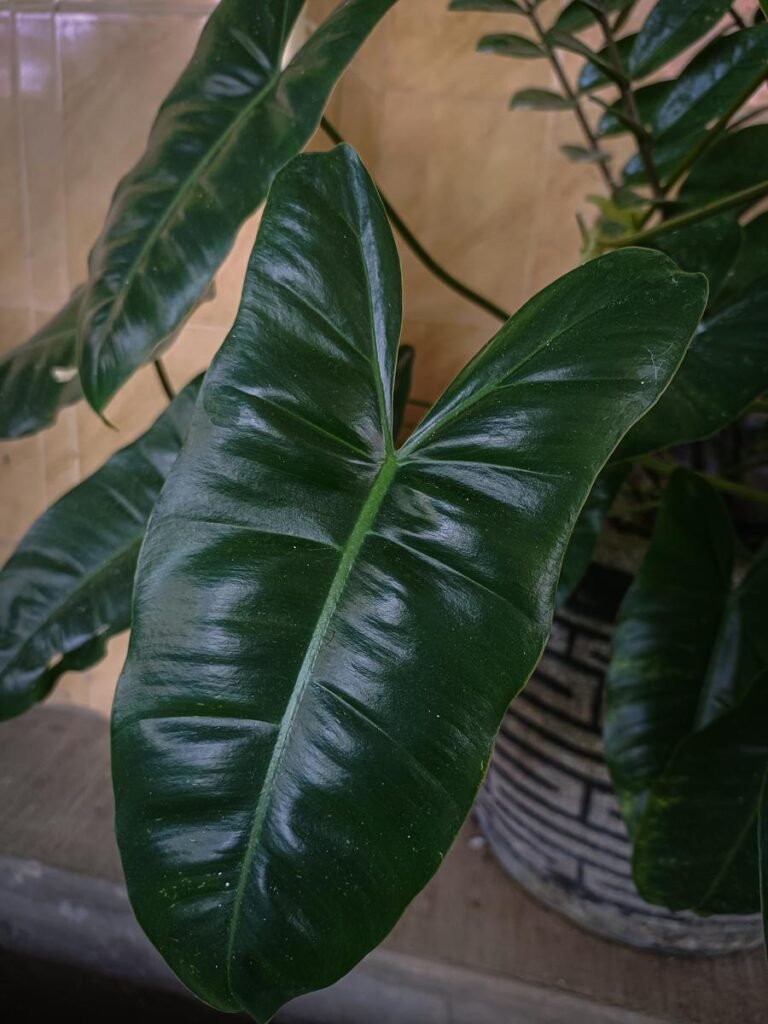
Identifying Philodendron Rugosum
Philodendron rugosum is a rare and exotic plant that is not very common in the market. Therefore, you might have some difficulty finding it or identifying it among other philodendrons. Here are some key features of philodendron rugosum that can help you recognize it:
- The leaves are thick, leathery, dark green, and have prominent veins.
- The leaves have a hide-like texture that wrinkles up as they come together with the stem.
- The leaves are shaped like pig ears or sow ears.
- The plant is a vine that can climb or cascade.
- The plant rarely flowers indoors.
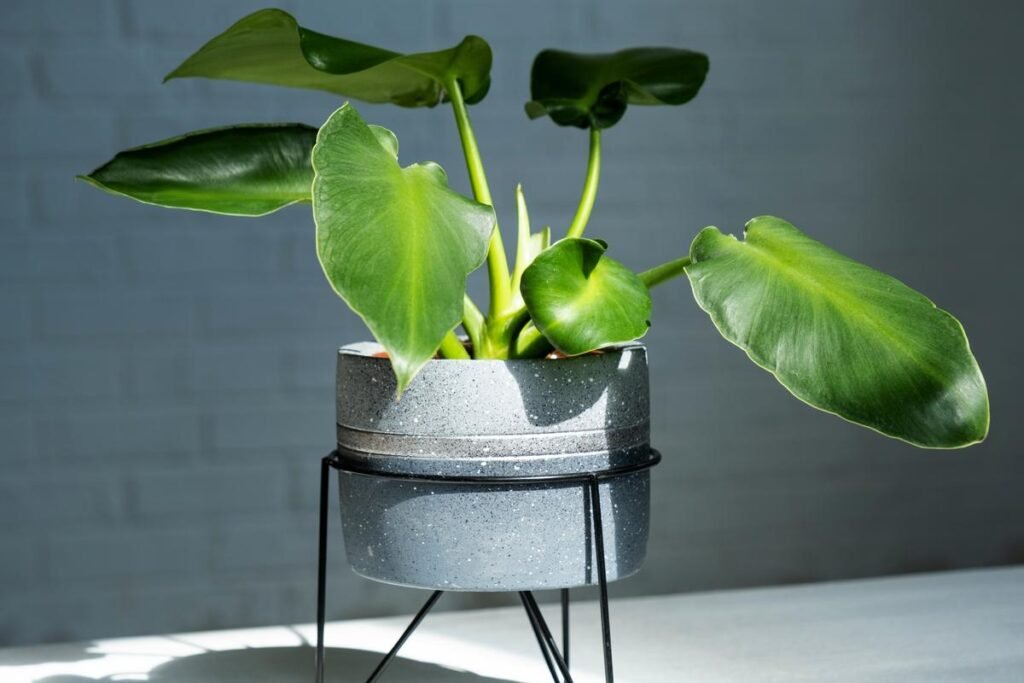
Key Features of Philodendron Rugosum
Philodendron rugosum is a rare and exotic plant that has some distinctive features that make it stand out from other philodendrons. Here are some of the key features of philodendron rugosum that you should know:
- Philodendron rugosum is a vine plant that can climb up a support or cascade from a hanging basket. It has aerial roots that help it attach to trees or other surfaces in its natural habitat. You can provide a trellis, a pole, or a moss stick for your plant to climb on, or you can let it trail from a shelf or a pot hanger. You can also prune your plant to control its size and shape.
- Philodendron rugosum has thick, leathery foliage with a hide-like texture and prominent veins. The leaves are dark green and have a glossy surface. They are shaped like pig ears or sow ears, hence the common names pigskin philodendron or sow’s ear plant. The leaves can grow up to 12 inches long and 8 inches wide, and they wrinkle up as they come together with the stem.
- Philodendron rugosum rarely flowers indoors, but when it does, it produces white spathes that surround yellow spadices. The flowers are not very showy and are often hidden by the foliage. The flowers are also not fragrant and do not attract pollinators. The flowers usually appear in late spring or early summer, and they last for a few weeks.
- Philodendron rugosum is a resilient and adaptable plant that can tolerate a wide range of conditions. It can grow in low to high light levels, as long as it is not exposed to direct sunlight. It can also withstand the average humidity levels in the house, but it prefers higher humidity levels above 60%. It can survive in temperatures ranging from 55 to 90 degrees Fahrenheit, but it does not like cold drafts or sudden temperature changes.
We have already discussed as How to Grow White Princess Philodendron with its Ultimate Care Guide
Essentials of Philodendron Rugosum Care
Philodendron rugosum is a rare and exotic plant that is easy to care for, as long as you provide it with some basic needs. Here are some of the essentials of philodendron rugosum care that you should follow to keep your plant healthy and happy:
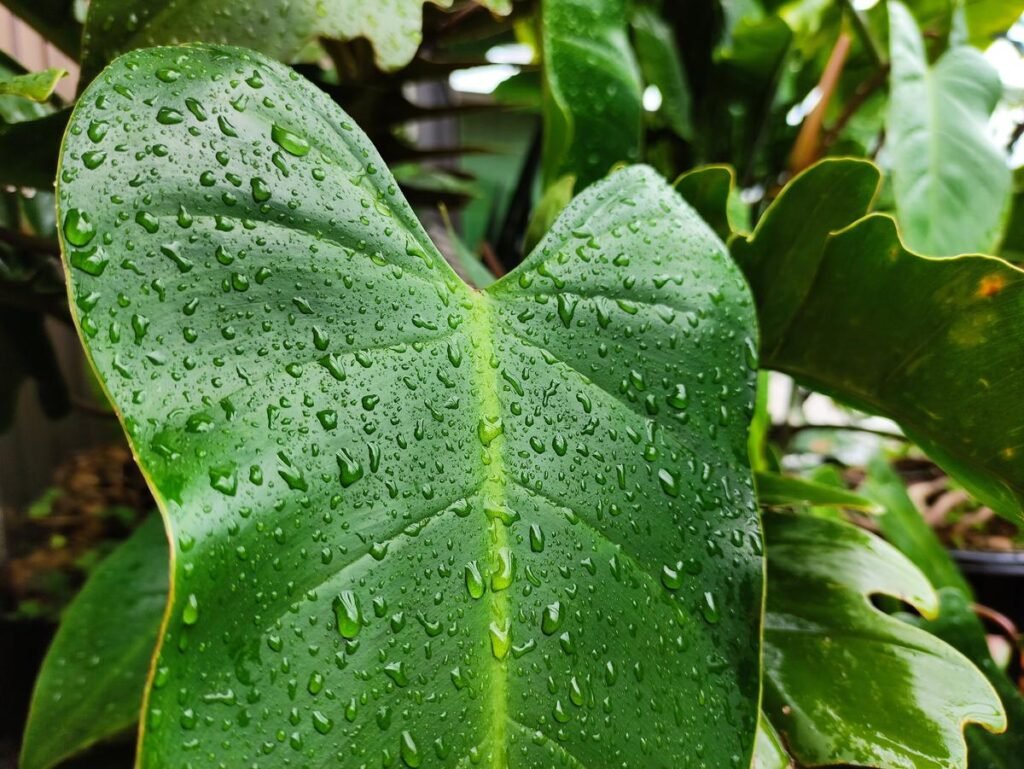
Proper Watering Techniques for Philodendron Rugosum
Philodendron rugosum loves moist soil and prefers to be watered when the top couple of inches of the soil are dry. You can check the soil moisture by inserting your finger into the soil or using a moisture meter. Water your plant thoroughly until the water drains out of the drainage holes.
You should avoid overwatering or underwatering your plant, as both can cause problems such as root rot, yellowing leaves, or dropping leaves. You should also avoid using tap water that contains chlorine or fluoride, as these can harm your plant. You should use filtered, distilled, or rainwater instead.
Significance of Pot Selection for Philodendron Rugosum
Philodendron rugosum needs a well-draining soil mix that contains orchid bark, perlite, and peat-rich soil. The soil pH should be slightly acidic, between 5.5 and 6.5. You can use a pH tester to check the soil acidity or add some vinegar or lemon juice to lower the pH. Also choose a pot that has drainage holes and is slightly larger than the root ball of your plant.
Also you should avoid using a pot that is too big or too small, as this can affect the water retention and root growth of your plant.
Lighting
Philodendron rugosum can adapt to various light levels, but it grows best in bright indirect light. You can place your plant at an eastern-facing window or a bit further away from a southern- or western-facing window.
Avoid direct sunlight as it can burn the foliage of your plant and also avoid placing your plant near windows as too little light makes it grow leggy and lose its color. Use artificial lights such as fluorescent or LED lights to supplement the natural light if needed.
Why Fertilizer Matters in Philodendron Rugosum Care
Philodendron rugosum benefits from regular fertilizing during the growing season, from spring to summer. You can use a liquid fertilizer and dilute it to half the strength recommended on the label and can apply the fertilizer every two weeks or every month, depending on the growth rate of your plant.
You should avoid fertilizing your plant in winter, as this is its dormant period and it does not need extra nutrients. Also avoid using a fertilizer that is high in nitrogen, as this can cause excessive leaf growth and reduce flowering.
Optimal Humidity Levels for Philodendron Rugosum
Philodendron rugosum likes high humidity levels, above 60%. You can increase the humidity by misting the plant, placing it on a tray of pebbles and water, or using a humidifier. You should mist your plant regularly, especially in dry seasons or when you use heating or cooling systems in your home.
Also keep your plant away from drafts, vents, or radiators that can dry out the air and should monitor the humidity level using a hygrometer and adjust it accordingly.
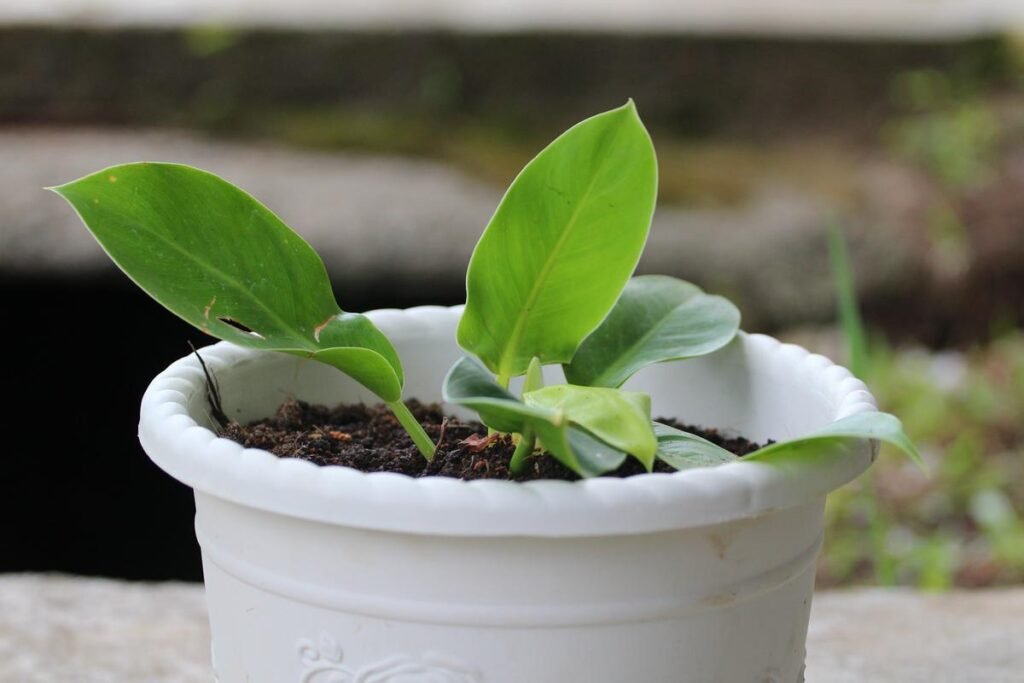
Tips on Repotting Philodendron Rugosum
Philodendron rugosum needs repotting every one to two years, or when the roots become too crowded in the pot. Repotting your plant will help it grow healthier and larger, as it will provide more space and fresh soil for the roots. Repotting your plant will also prevent root rot, which can occur when the soil becomes compacted and waterlogged. Here are some tips on repotting philodendron rugosum that you should follow:
When to Repot Philodendron Rugosum
The best time to repot your plant is in spring or summer, when the plant is actively growing and can recover faster from the stress of repotting. You can tell if your plant needs repotting by checking the following signs:
- The roots are growing out of the drainage holes or over the edge of the pot.
- The plant is wilting or drooping even after watering.
- The soil is drying out too quickly or staying too wet for too long.
- The plant is growing slower than usual or not producing new leaves.
Steps in Repotting Philodendron Rugosum
To repot your plant, you will need a new pot that is one size bigger than the previous one, a well-draining soil mix that contains orchid bark, perlite, and peat-rich soil, a pair of scissors or pruners, and some gloves. Here are the steps in repotting your plant:
- Put on your pair of gloves, as this plant is poisonous if ingested or touched by bare skin.
- Water your plant thoroughly a day before repotting, as this will make it easier to remove it from the old pot and reduce the shock of repotting.
- Gently remove your plant from the old pot by holding the stem and tapping or squeezing the sides of the pot. You can also use a knife or a spatula to loosen the soil around the edges of the pot.
- Inspect the roots and trim away any dead, damaged, or rotten roots with scissors or pruners. You can also divide your plant into smaller sections if you want to propagate it or reduce its size. To do this, cut through the stem and roots with a sharp and sterile knife, making sure that each section has at least one node (the point where leaves emerge) and some healthy roots.
- Fill the new pot with some fresh soil mix and make a hole in the center for the root ball. You can also add some gravel or charcoal at the bottom of the pot to improve drainage.
- Place your plant in the new pot and spread the roots evenly. Add more soil around the roots and press it lightly to eliminate air pockets. The soil level should be slightly below the rim of the pot and cover all the roots.
- Water your plant well until the water drains out of the bottom of the pot. You can also add some diluted liquid fertilizer to help your plant adjust to its new home.
- Place your plant in a bright spot with indirect light and keep it away from direct sunlight, drafts, or extreme temperatures. Keep it moist but not soggy for the first few weeks until it establishes itself in the new pot.
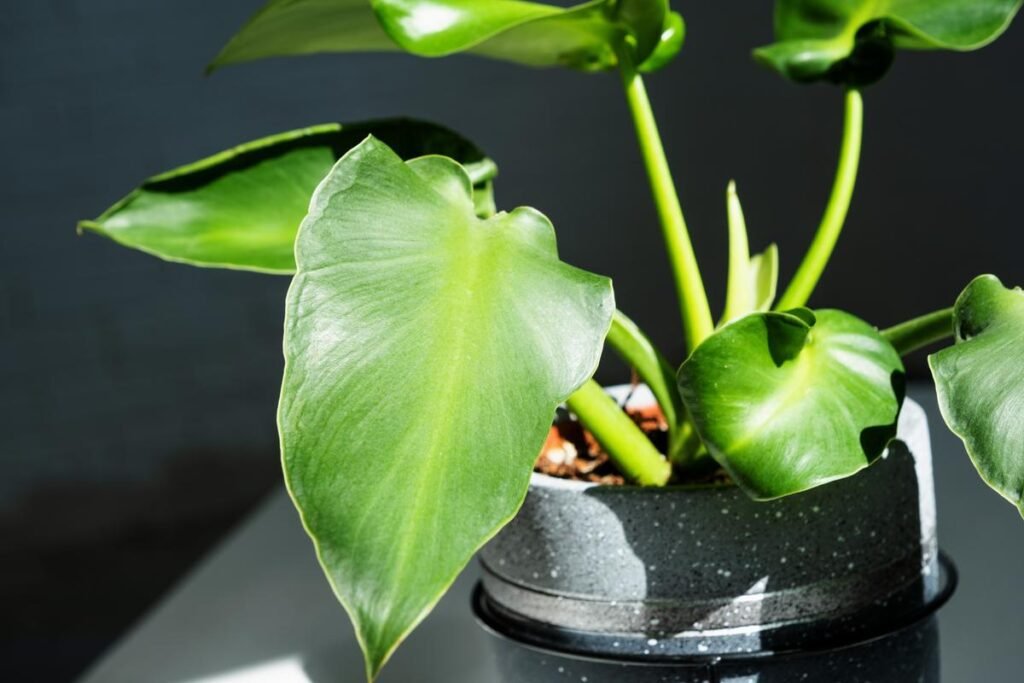
Dealing with Common Pests in Philodendron Rugosum
Philodendron rugosum is a resilient and adaptable plant that can withstand most pests and diseases. However, it is not immune to some common pests that can infest and damage your plant. Here are some of the common pests that you might encounter in philodendron rugosum care and how to deal with them:
Identifying Common Pests in Philodendron Rugosum
The most common pests that can affect your plant are spider mites and mealybugs. These are tiny insects that suck the sap from the leaves and stems of your plant, causing them to lose their color, curl, or drop. You can identify these pests by looking for the following signs:
- Spider mites: These are very small, red, brown, or green spiders that spin fine webs on the underside of the leaves or between the stems. They are usually found in dry and hot conditions, and they can multiply quickly if left untreated. They can cause the leaves to turn yellow, brown, or gray, and eventually fall off.
- Mealybugs: These are white, cottony bugs that cluster on the stems, leaf joints, or leaf veins of your plant. They secrete a sticky substance called honeydew, which attracts ants and fungal growth. They can cause the leaves to turn yellow, wilt, or drop.
Treatment and Prevention of Pests in Philodendron Rugosum
To treat and prevent these pests from infesting your plant, you can use the following methods:
- Wiping: You can wipe the leaves and stems of your plant with a damp cloth or a cotton swab dipped in alcohol. This will remove the pests and their eggs, as well as any honeydew or webbing. You should do this regularly, especially if you notice any signs of infestation.
- Spraying: You can spray your plant with a solution of water and insecticidal soap or neem oil. This will kill the pests and deter them from coming back. You should follow the instructions on the label and apply the solution every week or every two weeks until the infestation is gone. You should also spray your plant in the morning or evening, when the sun is not too strong, to avoid burning the foliage.
- Isolating: You can isolate your plant from other plants if you notice any signs of infestation. This will prevent the pests from spreading to other plants and reduce their population. You should also inspect your plant regularly and remove any affected parts.
- Maintaining: You can maintain your plant’s health and vigor by providing it with proper care. This includes watering it when the soil is dry, fertilizing it during the growing season, repotting it when needed, pruning it to control its size and shape, and keeping it in a bright spot with indirect light. A healthy plant is more resistant to pests and diseases than a stressed one.
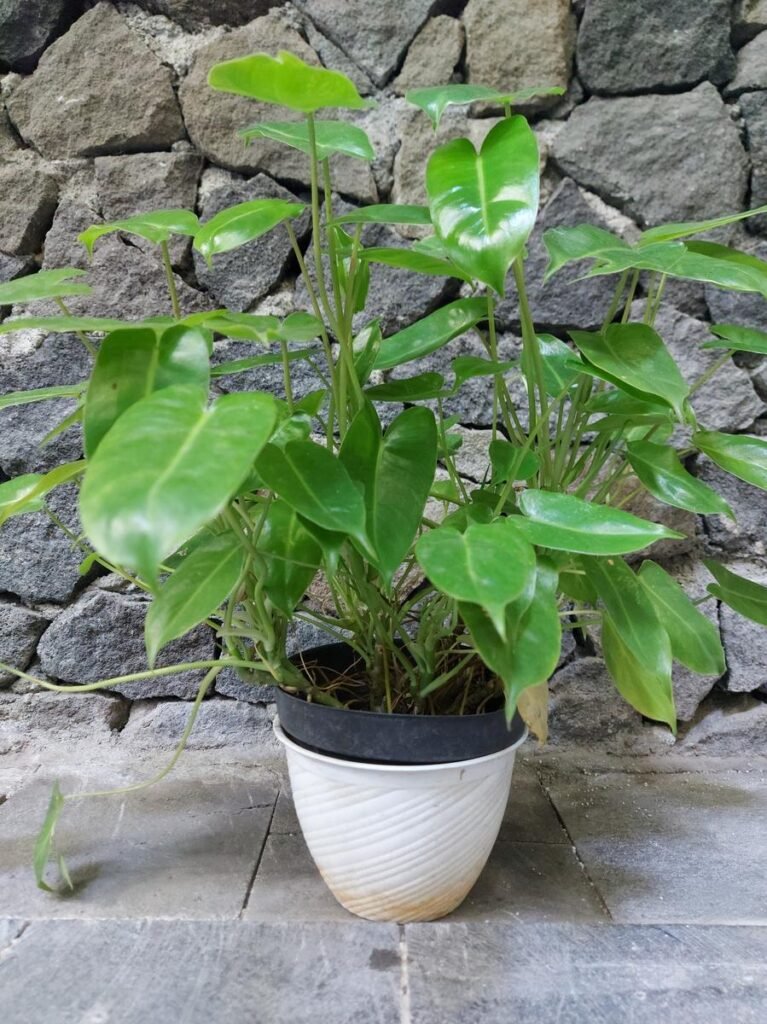
Common Problems and Solutions in Philodendron Rugosum Care
Philodendron rugosum is a resilient and adaptable plant that can grow well in most indoor conditions. However, it is not immune to some common problems that can affect its health and appearance. Here are some of the common problems that you might encounter in philodendron rugosum care and how to solve them:
Recognizing Common Problems in Philodendron Rugosum
The most common problems that can affect your plant are yellowing leaves, dropping leaves, curling leaves, or root rot. These are usually caused by overwatering, underwatering, low humidity, or poor drainage. You can recognize these problems by looking for the following signs:
- Yellowing leaves: This is a sign of overwatering, which can cause the roots to rot and the leaves to lose their chlorophyll. The leaves may also turn brown or black at the edges or tips. You can prevent this by watering your plant only when the soil is dry, using a well-draining soil mix and pot, and avoiding tap water that contains chlorine or fluoride.
- Dropping leaves: This is a sign of underwatering, which can cause the plant to lose its turgor pressure and wilt. The leaves may also turn yellow or brown before falling off. You can prevent this by watering your plant thoroughly until the water drains out of the pot, checking the soil moisture regularly, and placing your plant in a bright spot with indirect light.
- Curling leaves: This is a sign of low humidity, which can cause the plant to lose its moisture and curl up. The leaves may also turn brown or crispy at the edges or tips. You can prevent this by increasing the humidity around your plant by misting it, placing it on a tray of pebbles and water, or using a humidifier. You should also keep your plant away from drafts, vents, or radiators that can dry out the air.
- Root rot: This is a sign of poor drainage, which can cause the soil to become waterlogged and suffocate the roots. The roots may also become mushy, soft, or dark in color. You can prevent this by using a well-draining soil mix and pot, adding some gravel or charcoal at the bottom of the pot, and avoiding overwatering your plant.
Solutions to Common Problems in Philodendron Rugosum Care
Solutions to common problems in philodendron rugosum care: To solve these problems, you can use the following methods:
- Adjusting your watering and humidity levels: You can adjust your watering and humidity levels according to the needs of your plant. You should water your plant only when the top couple of inches of the soil are dry, and mist it regularly to increase the humidity. You should also use filtered, distilled, or rainwater instead of tap water that contains chlorine or fluoride.
- Improving your soil drainage: You can improve your soil drainage by using a well-draining soil mix that contains orchid bark, perlite, and peat-rich soil. You can also add some gravel or charcoal at the bottom of the pot to improve drainage. You should also choose a pot that has drainage holes and is slightly larger than the root ball of your plant.
- Trimming away the affected parts: You can trim away any dead, damaged, or rotten parts of your plant with scissors or pruners. This will prevent the infection from spreading to other parts of your plant and help it recover faster. You should also sterilize your tools before and after using them to avoid contaminating your plant.
- Repotting your plant: You can repot your plant if it has root rot or if it has outgrown its pot. You should repot your plant in spring or summer, when it is actively growing and can recover faster from the stress of repotting. You should use a fresh soil mix and a new pot that is one size bigger than the previous one.
Conclusion
Philodendron rugosum is a rare and exotic plant that will add a touch of tropical flair to your indoor space. This plant has thick, leathery foliage with a hide-like texture and prominent veins. It is also known as the pigskin philodendron because of the shape and texture of its leaves. Philodendron rugosum is native to Ecuador, where it grows in the rainforests of the Andes mountains. It is a vine plant that can climb up a support or cascade from a hanging basket.
Philodendron rugosum is a great indoor plant for beginners and collectors alike. It is resilient, adaptable, and easy to care for. It can thrive in a wide range of conditions, as long as you provide it with some essentials of care. These include watering it when the soil is dry, using a well-draining soil mix and pot, placing it in a bright spot with indirect light, fertilizing it during the growing season, and increasing the humidity around it.
You should also repot your plant every one to two years, or when the roots become too crowded in the pot. You should also inspect your plant regularly and deal with any common problems or pests that might affect it.
Philodendron rugosum is a beautiful and unique plant that will bring joy and color to your home. However, you should be aware that this plant is poisonous if ingested by humans or pets. It contains calcium oxalate crystals that can cause irritation, swelling, and burning of the mouth, throat, and stomach. Therefore, you should keep this plant away from children and animals and wear gloves when handling it.
We hope this article has helped you learn more about philodendron rugosum care and inspired you to grow this rare and exotic plant in your home. If you have any questions or comments, please feel free to leave them below. Happy gardening!


